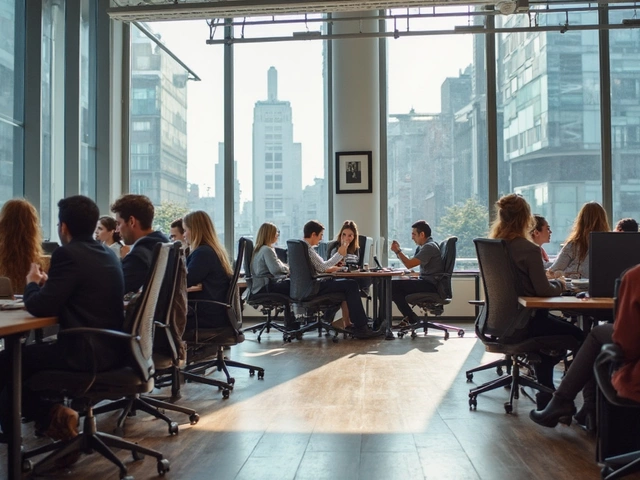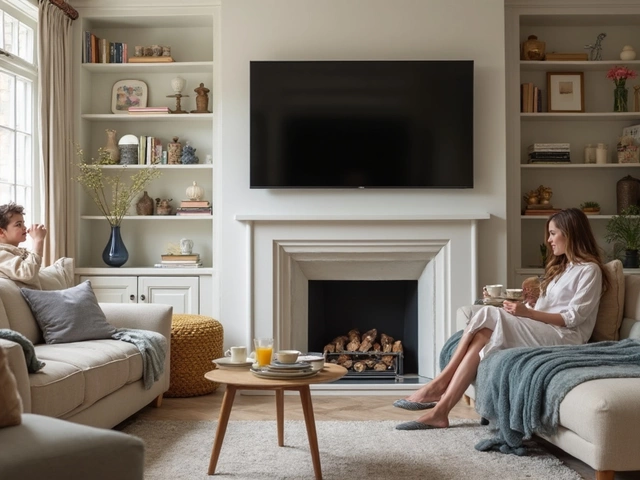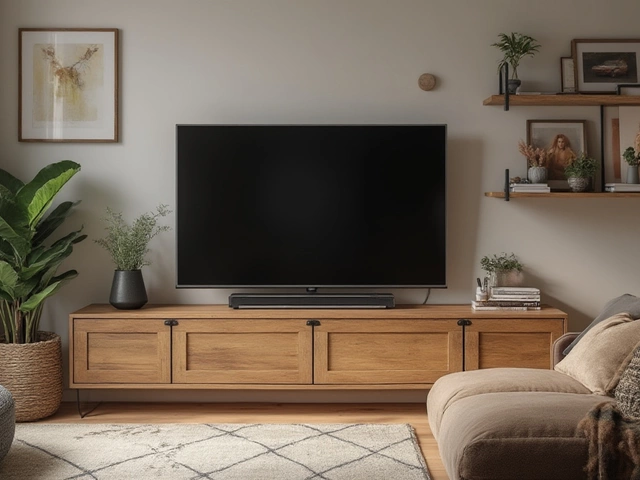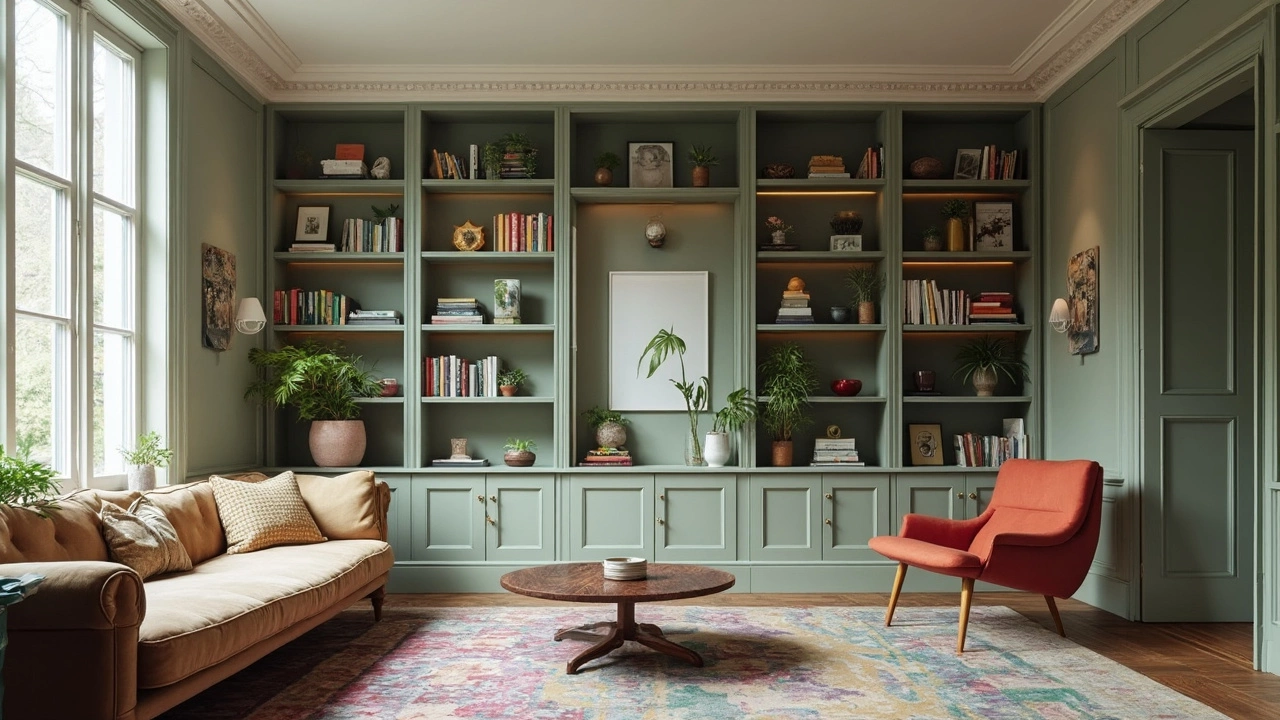 16
Jun,2025
16
Jun,2025
If you’ve ever stared at the wall in your living room and wondered if those built in bookshelves are dragging your space down, you’re not alone. People debate this every year: are built ins old school, or still a smart move if you want your place to feel fresh? Here’s the real story—built in bookshelves never totally go out of style, but how they look, and how you use them, changes all the time.
Some folks think built ins are leftover relics from those 1980s houses with popcorn ceilings and heavy oak everywhere. But walk into a newly remodeled home, and you’ll often see designers adding sleek, painted shelves straight into the walls. Why? They save space and give you a spot to show off not just books, but everything from vinyl records to plants and family photos.
Don’t feel pressured by online trends saying you need everything minimal or open. If your built ins serve a purpose, and you like them, the solution might be tweaking the style instead of tearing them out. And yes—there are plenty of ways to do that without breaking the bank or hiring a contractor for weeks on end.
- The History and Comebacks of Built In Bookshelves
- What Styles Are Hot (and What’s Not) Right Now
- Modern Makeovers: How People Update Built Ins in 2025
- Practical Perks That Never Go Out of Style
- Tips for Making Built In Bookcases Work in Any Room
The History and Comebacks of Built In Bookshelves
Built in bookshelves go way back—think late 1800s craftsman homes and fancy Victorian libraries. Back then, shelves built right into the walls showed you had books, taste, and money. Over time, these shelves moved out of just libraries and into living rooms, hallways, and bedrooms in homes built from the 1930s all the way through the 1970s.
By the 1980s and 90s, every classic American builder-grade home seemed to have built ins, usually flanking a fireplace or jammed into a den. Styles changed—some were big, glossy, and ornate, while others were simple and cheap. But you could spot them everywhere. Then came the 2000s, and open concept living took over. Suddenly, those built in bookcases looked bulky compared to IKEA cubes and floating shelves.
Here's the twist. Around 2015, interior designers started putting built in bookshelves back into homes. The pandemic era saw another big surge, as people needed home offices and a spot for all those books, puzzles, and Zoom backgrounds. According to the National Association of Home Builders, built in shelving requests went up 19% between 2020 and 2022 as people rethought their living setups.
| Decade | Reason for Popularity |
|---|---|
| 1920s-1940s | Showcase luxury and literacy |
| 1960s-1970s | Practical family storage |
| 1980s-1990s | Fireplace focal points, mass adoption in new builds |
| 2000s | Moved out of fashion for "open living" trends |
| 2015-now | Resurgence for style and usefulness, especially in remote work times |
So, built ins have gone through some ups and downs. But they always seem to find their way back. Every decade brings a twist in style, from chunky wood and glass cabinets to clean, painted finishes that blend into the wall. If you’re seeing them get popular again on Instagram and in home stores, you’re not imagining it—they’re legit back, just with a modern look.
What Styles Are Hot (and What’s Not) Right Now
If you're thinking about built in bookshelves, forget the dark wood monsters your grandma probably dusted every Saturday. Right now, it’s all about clean lines, lighter finishes, and designs that blend into the wall but still stand out with good styling. You’ll see painted built-ins, especially in soft whites, warm taupes, or even deep navy—a color that’s been everywhere since 2023.
Open shelves mixed with cabinets below are a big hit, too. They give you a spot to stash not-so-pretty stuff while keeping the top open for books and decor you want to show off. Newer built-ins often come with simple trim and barely-there hardware, steering clear of the super-ornate moldings of the past.
What’s out? Those bulky, golden oak built-ins or over-the-top carved details that scream 1990s McMansion aren’t making a comeback. Another thing fading: built-ins that swallow a whole wall from floor to ceiling, unless they’re broken up with contrasting colors or materials.
| Hot Styles (2025) | Outdated Styles |
|---|---|
| Clean-lined, painted wood Open shelving with closed cabinet mix Integrated lighting (LED strips, puck lights) Hidden desk space Soft or bold accent colors | Heavy oak or cherry finishes Overly ornate trim One-size-fits-all, wall-to-wall shelving Built-in desks with no cable management Fixed shelves (not adjustable) |
Brooke Wagner, a designer who’s been featured in Architectural Digest, puts it this way:
"The best built-ins today almost disappear until you style them—think sleek, but with personality. Leave heavy woods and fussy details behind."
If you want your bookshelves to feel up to date, focus on good lighting, adjustable shelves, and a color that works with the rest of your room. Little details, like swapping out the hardware or even painting the back of the shelves a fun color, can pull everything into this decade without spending much.
- Use a contrasting paint color on the back panel
- Add stick-on LED lighting for mood and display
- Mix in art or plants between the books
- Keep shelf styling simple and uncluttered
So, if your built in bookcases look like a flashback to 1994, updating the doors, lighting, or just the way you arrange stuff can make a huge difference—no sledgehammer needed.
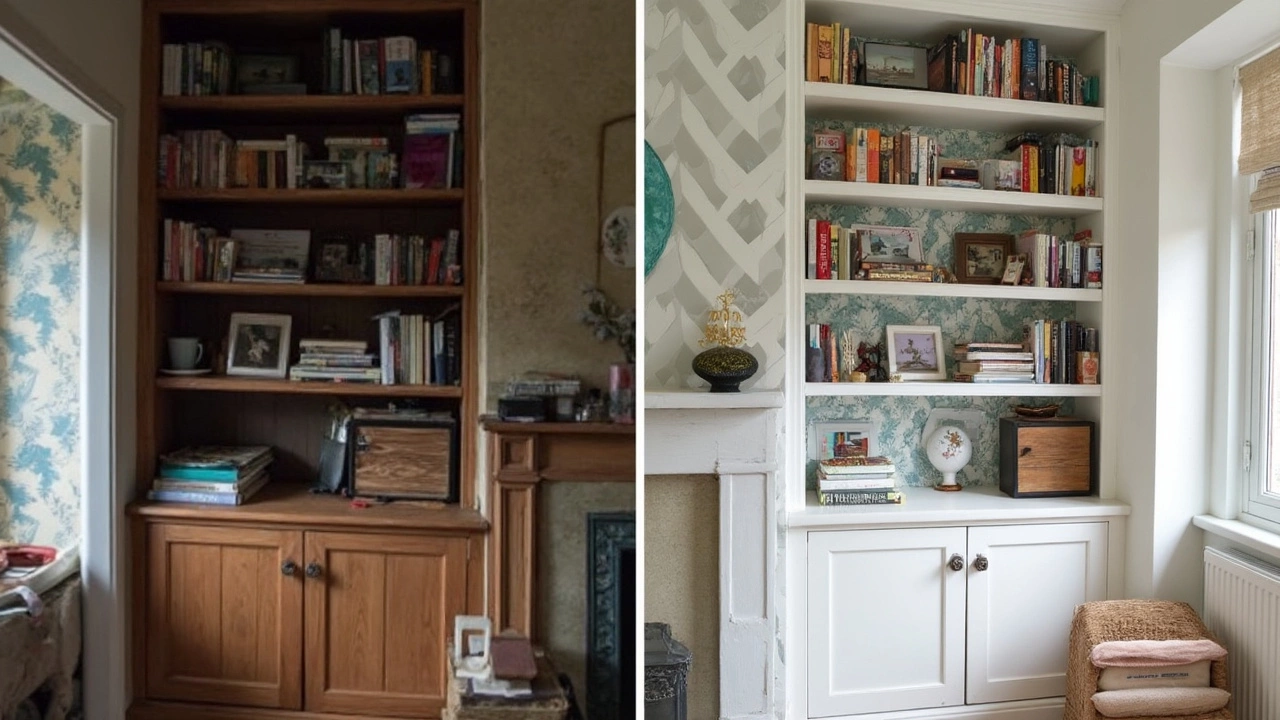
Modern Makeovers: How People Update Built Ins in 2025
People aren’t just slapping a coat of paint on built ins anymore. In 2025, updates are all about mixing function and style while making the shelves work hard for the space. Designers are using smart changes to turn old, boring bookcases into statement pieces—or even multi-use storage that hides mess instead of showing it off.
The biggest trend? Clean lines and simple shapes. Folks ditch bulky trim and busy details, swapping them for straight edges and thin frames that blend with the walls. It’s way more common now to see bookcases painted the same color as the wall, sometimes even using textured paints or matte finishes to give shelves a subtle, modern edge.
- Built in bookshelves are getting glass or metal doors to keep dust off and add a sleek touch. Clear glass lets you show collectibles, while tinted glass makes things look tidier.
- Some people add track lighting, LED strips, or puck lights right inside the shelves to spotlight certain objects or make reading easier. LED shelf lighting shot up in sales by 31% in the last year, mostly in built ins installed around entertainment centers or work-from-home nooks.
- The lower cabinets of built ins are often used for storing tech, games, or even small home bar setups. Pull-out drawers and hidden charging stations are standard upgrades now.
If your home leans more classic, don’t panic—mixing old and new works too. You might leave the wood but update the hardware, or add wallpaper or peel-and-stick wood panels behind the shelves for a pop of color or texture. A lot of realtors say these small changes raise a home’s appeal without a full remodel.
Here’s a quick look at what’s getting the biggest upgrades in 2025:
| Update Style | 2024-2025 Popularity (%) |
|---|---|
| Painted the Same as Wall | 62 |
| LED Shelf Lighting | 31 |
| Hidden Storage Drawers | 29 |
| Back Panel Accent (Wallpaper or Wood) | 24 |
| Glass or Metal Doors | 22 |
So if you want your built ins to feel up-to-date, think clean, practical, and a little bit personal. Skip the fussy details and focus on stuff that makes life easier and looks like it belongs in 2025, not 1985.
Practical Perks That Never Go Out of Style
Let’s be honest—no matter what’s trending on Instagram this month, it’s tough to beat the everyday usefulness of built in bookshelves. They’re not just for showing off your latest book haul. These shelves turn what would be wasted wall space into storage for everything, which is a big win in small homes and apartments.
One of the top reasons people keep built ins even when they remodel is how easily they cut clutter. Unlike store-bought shelves, built ins don’t jut out into the room. They look like they belong—and that helps any space feel less cramped.
- Customization: Built ins fit odd spots—think alcoves, fireplace surrounds, even under stairs. Try finding a store-bought bookcase for that weird corner. Not happening.
- Increased Home Value: According to a 2024 survey by HomeLight, homes with quality built in shelving saw resale prices about 5-7% higher than similar homes without them.
- Easy Organization: With adjustable shelves and cabinet doors, you can stash stuff you don’t want seen (hello, cable boxes) or put special collections front and center.
- Space Saver: Especially in rooms with less square footage, floor-to-ceiling shelving stores more without gobbling up precious floor space.
If you want numbers, check out this quick snapshot based on a study by the National Association of Home Builders:
| Feature | Homeowners Who Want It (%) | Main Reason |
|---|---|---|
| Built in Bookcases | 61% | Adds storage, looks custom |
| Freestanding Bookcases | 27% | Easy to move |
| No Bookcases | 12% | Prefer open wall space |
The best part? Built ins don’t just store books. People use them for gaming gear, board games, office supplies, bar setups, or even pet beds. If you’re clever about what to display, your shelves become a working part of your daily life, not just something that collects dust.
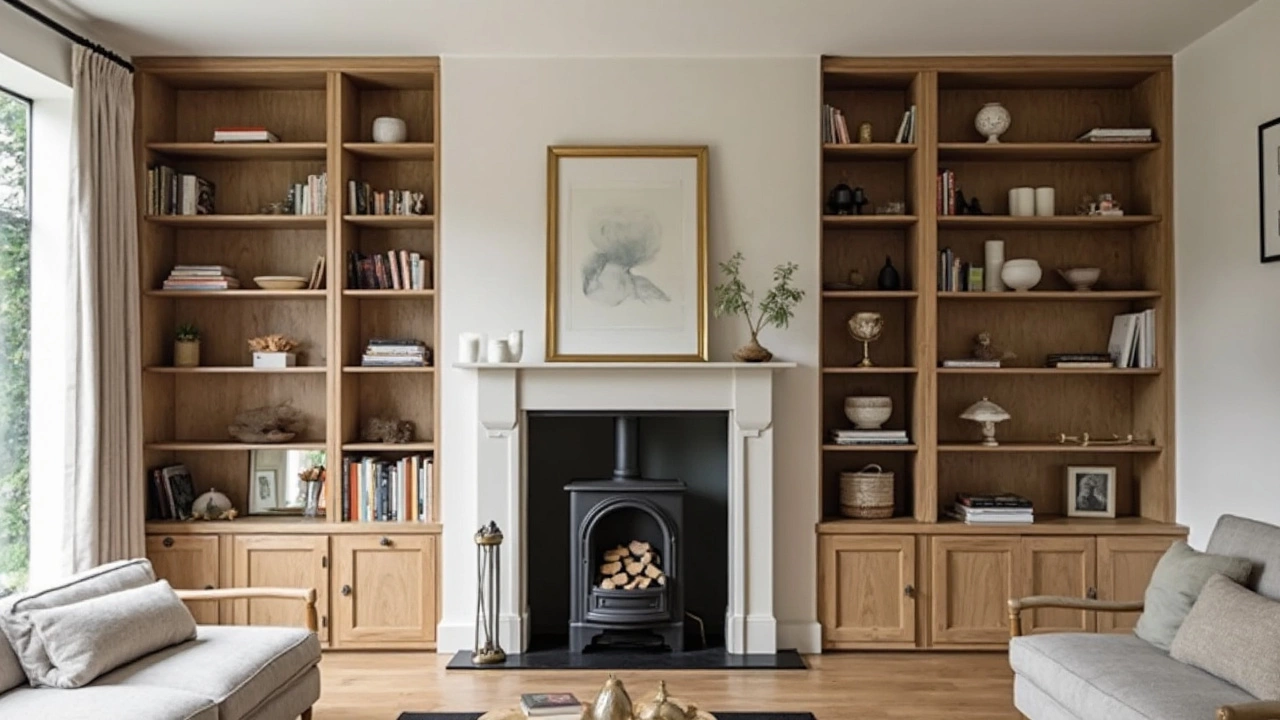
Tips for Making Built In Bookcases Work in Any Room
Bringing out the best in built in bookcases isn’t just for big libraries or living rooms. You can make them practical and stylish almost anywhere—think bedrooms, kitchens, home offices, or even hallways. The trick is getting the layout, color, and function right for the specific room.
- Paint and Trim: Give shelves a new look with a coat of paint or contrasting trim. White shelves blend in for a clean feel, but navy blue or sage green can pop in the right space. In smaller rooms, painting built ins the same color as the walls helps make the room feel bigger.
- Lighting Matters: Built-in lights or even stick-on LEDs can really change things up. Good lighting makes a cramped nook look purposeful, not like wasted space.
- Adjustable Shelves: Flexibility is key. Adjustable shelves let you fit everything from oversized art books to tiny collectibles.
- Use the Lower Space: The bottom half is perfect for cabinets, drawer storage, or even baskets. It keeps clutter out of sight—super handy for kids’ rooms or mudrooms.
- Style with Intention: Don’t just fill every inch with stuff. Mix in plants, framed photos, or even a couple of empty spots for breathing room. Too much makes it feel dated or heavy.
If you’re using built in bookshelves for actual books, try grouping them by color or stacking some horizontally and some vertically for texture. Don’t forget to leave room for your personality. Throw in a quirky sculpture, a favorite candle, or a memento from a trip—it stops your shelves from feeling like every other Pinterest post.
For renters or anyone not ready for power tools, removable wallpaper or peel-and-stick tiles work wonders as a backdrop inside your shelves. It’s a fast, cheap way to update the look without a big commitment.
Still debating if your space is suited for built ins? Here’s where people put them most often, and why:
| Room | Main Use | Top Tip |
|---|---|---|
| Living Room | Media, books, decor | Float shelves around the TV for extra storage |
| Bedroom | Nightstand replacement, personal touches | Built-ins above the headboard = big space saver |
| Home Office | Files, books, supplies | Add closed cabinets to hide clutter |
| Kitchen | Cookbooks, dishes | Try glass doors or open shelves for easy access |
| Hallway | Display, overflow storage | Keep depth shallow for easier movement |
Bottom line: built in bookcases work anywhere if you match the design and function to the room. Focus on what you actually need to store or show off, and don’t be afraid to change things up when your needs shift.

